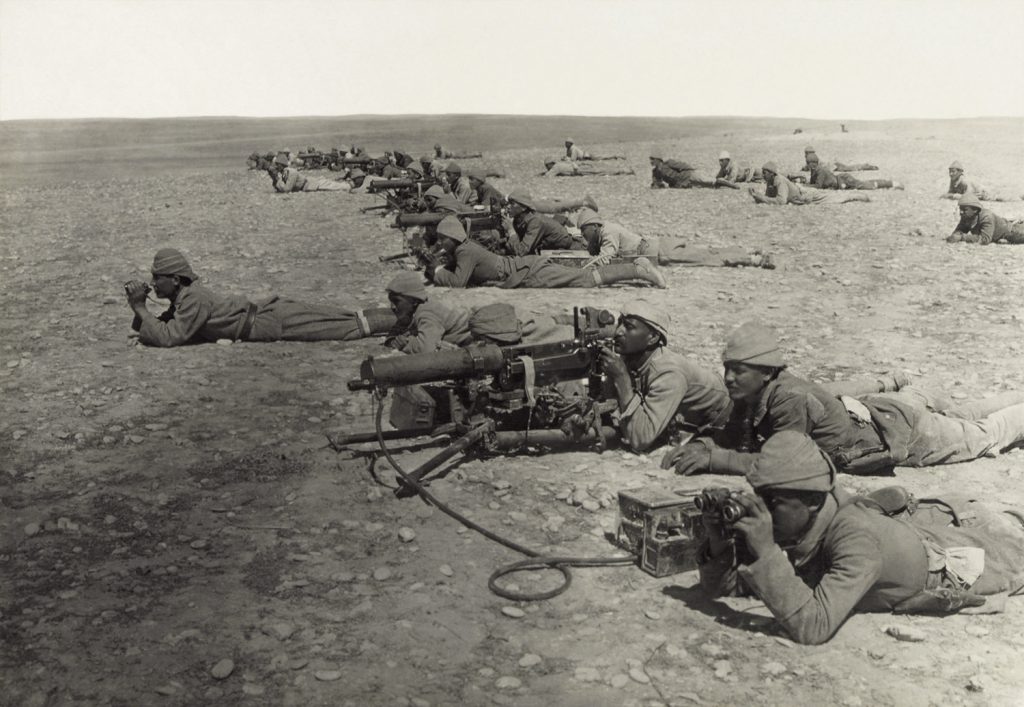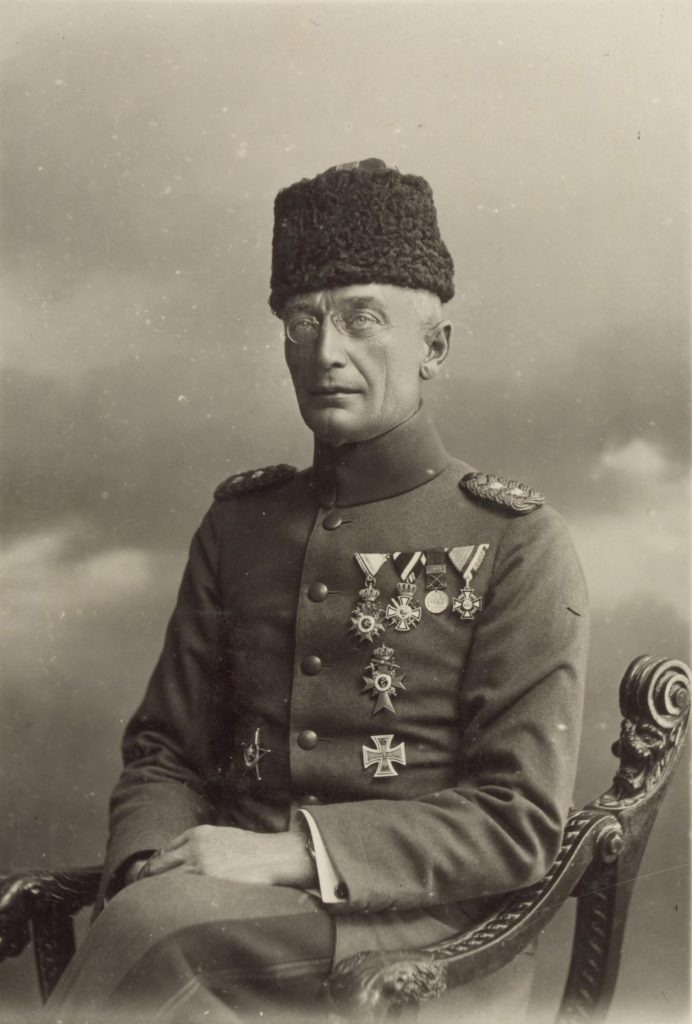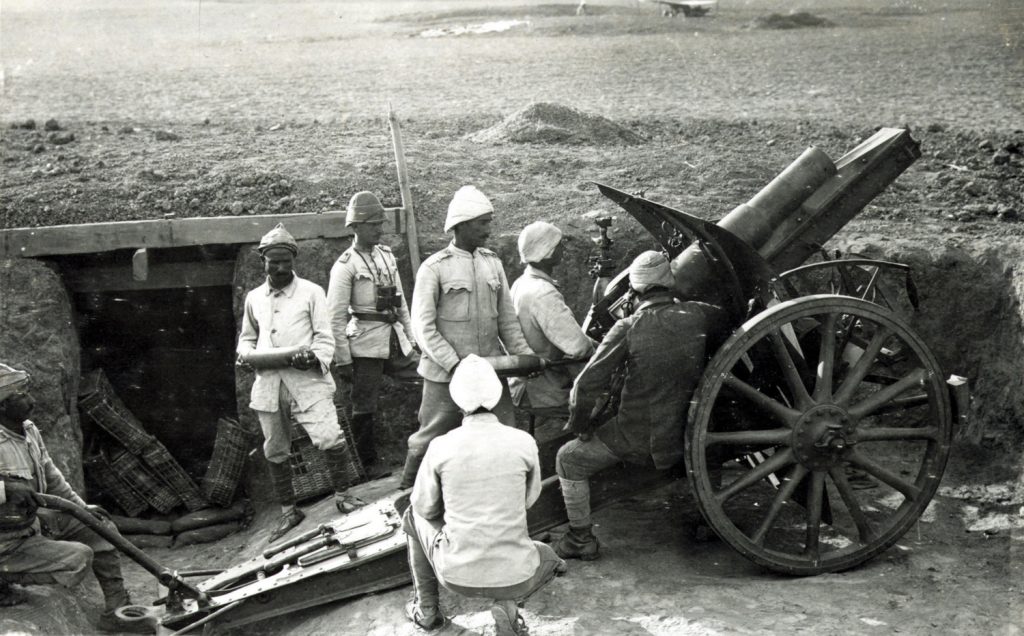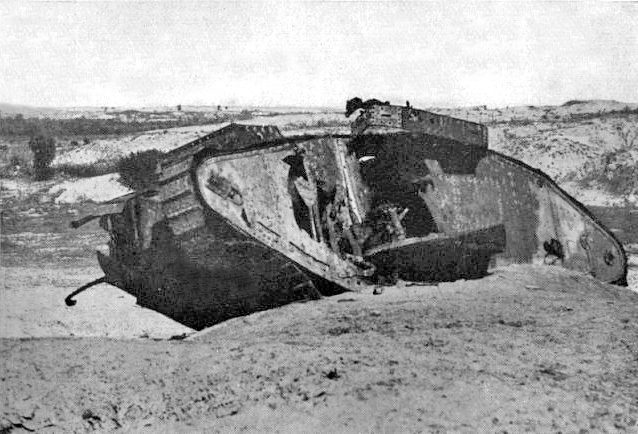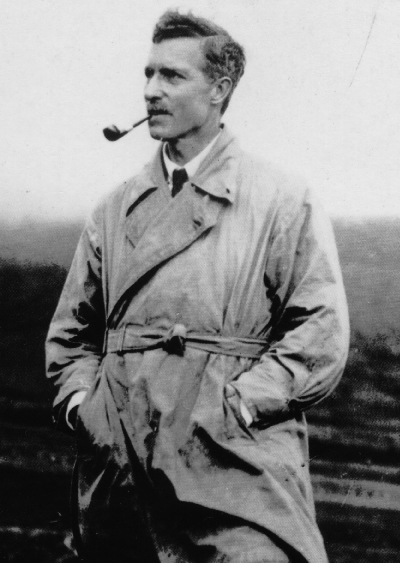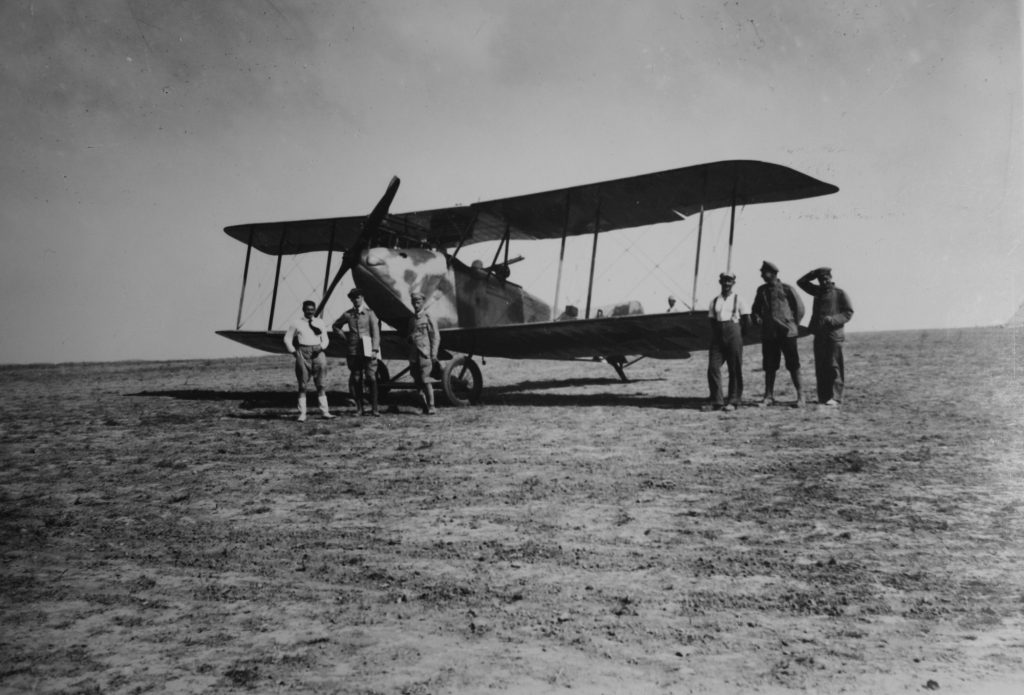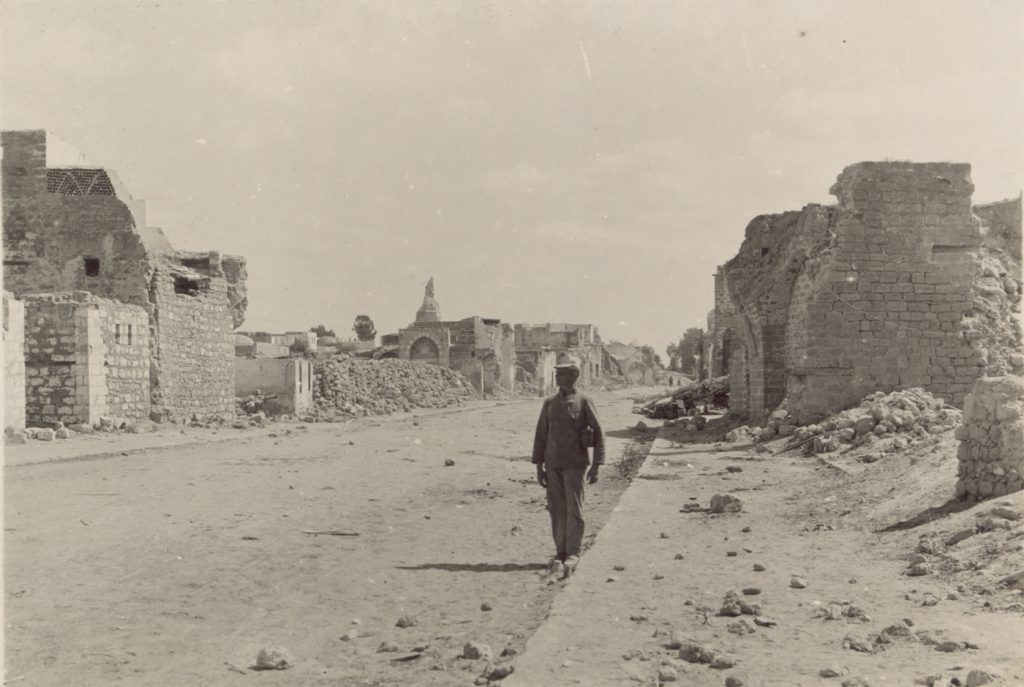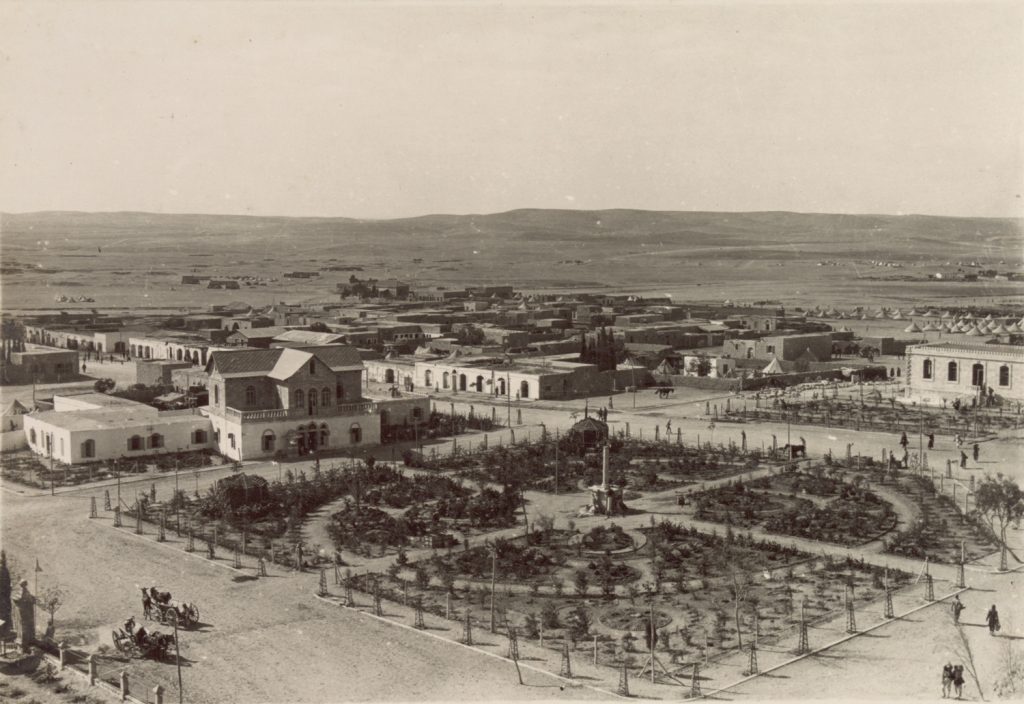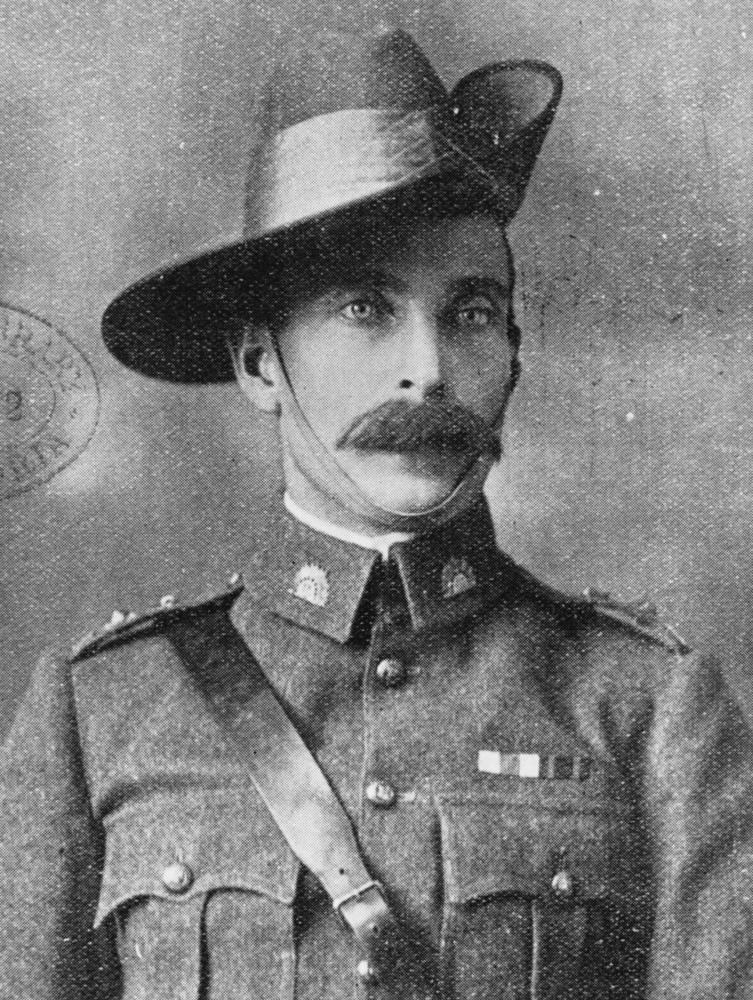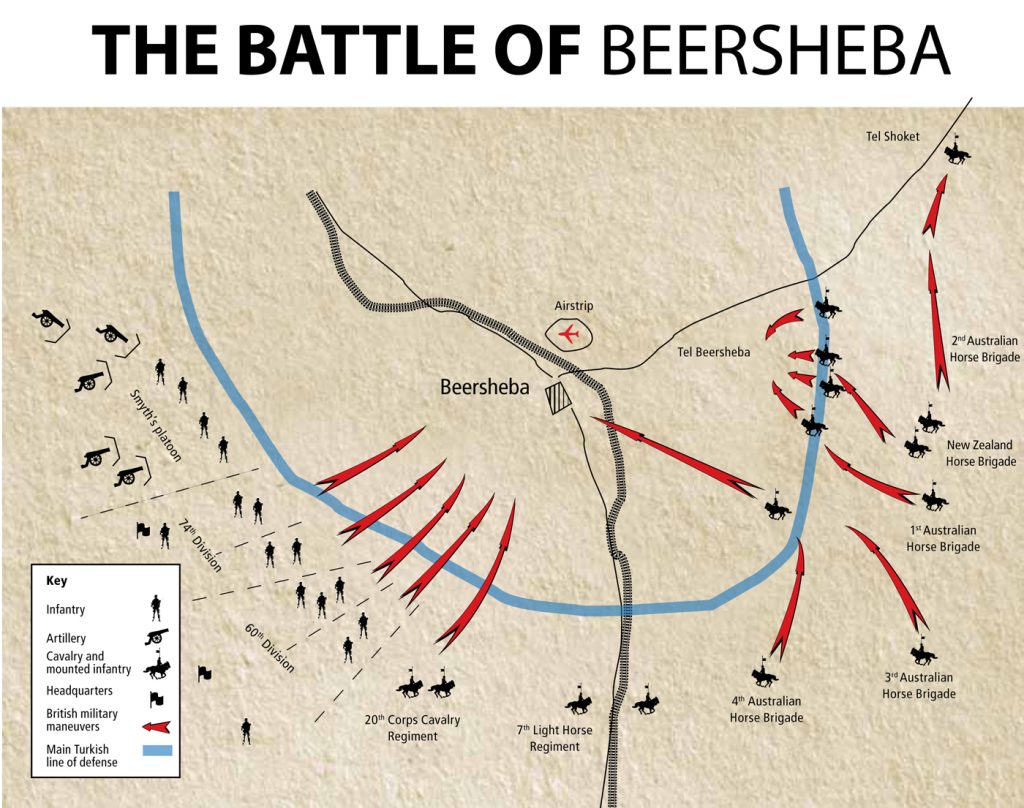Defending the Canal
Volatile to its very core at the outbreak of World War I, the Middle East was divided between the superpowers of western Europe and the “sick man” to the east, the Ottoman Empire. Palestine, the Arabian Peninsula, Lebanon, and Syria were all under Ottoman control. Egypt had been part of the British Empire since 1882, despite Turkey’s insistence that the country was an Ottoman province. With limited forces stationed in the Middle East, Britain’s primary objective was to defend the Suez Canal, a crucial shipping passage for the British Empire. British forces therefore withdrew from the Sinai Peninsula and regrouped on the west bank of the canal, leaving the east bank open to attack.
Sure enough, in January 1915, the Turkish and German armies launched an offensive, reaching the canal. Not satisfied with disrupting imperial shipping, they attempted a crossing, which was deflected by the British. Belatedly realizing that the Suez’s eastern defenses were also critical, British forces deployed thirty kilometers east of the canal. A second Turkish-German attack and a series of raids convinced the British that the best defense was a good offense, prompting an advance through Sinai into Palestine in order to keep the enemy a safe distance from the vital canal.
Turkish artillery soldiers in position at Tel Shara, a defensive post in the lines stretched by the Germans and Ottomans between Gaza and Beersheba, 1917
The British army took its time, though, deploying only in March 1916. The disastrous Gallipoli campaign had taken up most of Britain’s military energy in the east throughout much of 1915. But once those forces (including the Zion Mule Corps) had been evacuated and reassigned to Egypt, troops became available. Initially the British offensive included a mere three divisions, commanded by General Archibald Murray. Many of these fifty thousand soldiers were not even combat forces. The Turkish Fourth Army defending Palestine and Syria was double that size, but only some of the troops were ready for battle.
Murray advanced slowly along the coastline, laying a railroad as he went. The Sinai had to be defended against possible Turkish incursions and equipped to provide soldiers at the front with water and other supplies. A logistics base was built in El-Arish, in the northern Sinai, which could easily be reached along the coast or by sea. To secure it, the British decided to conquer Gaza – the largest city in the region – creating a line of defense north of El-Arish. In January 1917, nine months into the campaign, troops finally reached Gaza and prepared to attack.
Three Turkish divisions were arrayed along the Gaza-Beersheba line under the command of German general Kress von Kressenstein. The general expected the British to try to take over Gaza and its water supplies and then use the city as a base from which to proceed deeper into Palestine. For thousands of years, in fact, Gaza had been the southern gateway to the Holy Land. General von Kressenstein deployed his forces southwest of the city, presuming his opponents would take the convenient coastal route through Sinai to Palestine. Lacking portable water tanks, he also needed to keep his forces close to the sea for easy resupply.
General Friedrich Kress von Kressenstein, born in 1870 to an aristocratic Prussian family whose sons filled numerous posts in the German army in World War I. Enlisting in the artillery corps in 1888, Kressenstein was among the German commanders advising the Ottoman army. Photo from 1916
Lost in the Haze
Formed specially for the Gaza invasion, the Imperial Cavalry Division numbered twelve thousand soldiers from all over the British Empire. The aggressive Imperial Camel Brigade and the Indian Fifteenth Cavalry Brigade also fought for Palestine along with various British infantry units, including of course the three Jewish brigades.
Pitted against them were two powerful Turkish defense systems, in Gaza and Beersheba, with mobile troops stationed at a string of guard posts between the two cities. The line of defense stretched along the modern-day international boundary – from Auja al-Hafir (Nitzana) to Ein Salela (Ein Habesor) to Khan Yunis.
Gaza’s small Turkish garrison was more than sufficient in view of German air cover plus the sand dunes and other natural barriers surrounding the city. Beersheba housed the regional Turkish headquarters, defended by an infantry battalion and a small cavalry regiment.
Britain’s Lieutenant General Charles Dobell planned a direct assault by a reinforced infantry division, with the Anzac (Australian and New Zealand Army Corps) Mounted Division and the Imperial Cavalry Division blocking the advance of Turkish reinforcements and ready to attack the city from the east.
Concealed by darkness and fog, British forces took up their offensive positions on the morning of March 26, 1917. They encountered fierce resistance, resulting in heavy casualties on both sides. The severe lack of water and inability to replenish supplies made Dobell uneasy, and although after a full day’s battle the Turkish were in retreat, he failed to press his advantage. Lest hunger and thirst force his troops to give up before the enemy did, he ordered them to withdraw. Several British field commanders, knowing how close they’d come to overcoming Gaza’s defenses, described the result as defeat snatched from the jaws of victory.
Next morning, realizing their mistake, the British swiftly reattacked. But the Turks had used the respite to redeploy and pushed them back with major losses. The First Battle of Gaza ended with 4,000 British casualties and prisoners, as opposed to 2,500 on the Turkish, Austrian, and German side.
“Sir Archibald”’s Failure
As far as the British were concerned, this was just a setback. General Murray sent an overly optimistic report to his commanders in Britain, listing his “achievements.” The government then ordered him to capitalize on his gains, capture Gaza, and advance further into Palestine. British prime minister Lloyd George desperately needed a morale booster after the appalling casualties on the French front – at the Somme and Verdun – in 1916. He was also convinced that another resounding Ottoman defeat, following on British strides in Mesopotamia just a month earlier, would finally topple the “sick man of Europe.”
In comparison with the Turks, the British army was well supplied. Railroads and water lines stretched from Egypt across Sinai as far as the front-line military headquarters at Deir el-Balah. The troops were armed with state-of-the-art weapons unknown to the Middle East – eight tanks, each with its own nickname. The British assumed the enemy would cower before “Sir Archibald,” “War Baby,” “Tiger,” and the rest, and having doubled the number of cannons available for the attack (170 for 35,000 soldiers), they anticipated a quick, clean victory.
Outnumbered and outgunned, the Turks concentrated on reinforcing their defenses. Hampered by logistic obstacles and lack of manpower, they used the three weeks between battles to add cannons and strategically place their eighteen thousand men in order to maximize cover.
The second British attack on Gaza commenced with two days of continuous shelling, including two thousand poisonous gas shells. On April 19, the actual assault began. Using the same tactics as in the previous battle, but this time against much improved fortifications, the British soon found themselves in trouble. Their maps failed to show slight differences in altitude, which gave the Turks the advantage. While British shelling had damaged Turkish trenches, Turkish firepower was undiminished. The tanks proved as useless as they had been on European battlefields. Though frightening at first sight, they moved so slowly that they were an easy target. Several ground to a halt as a result of mechanical failure, and Turkish artillery destroyed three. Some managed to inflict severe damage, but the fact that they couldn’t necessarily function together marginalized their impact.
Wherever they did breach Turkish fortifications, the British lacked sufficient forces to withstand counterattacks. Nightfall found British forces with heavy losses and minimal gains, while the Turks held their ground with relative ease. General Murray had no choice but to retreat.
The battle had been devastating for the British. The official six thousand casualties (versus two thousand for the Turks) included five hundred dead, though some claim the true numbers were double that. The British troops’ only achievement was the conquest of nearby Ein Habesor and the discovery of a Byzantine mosaic there.
The battle for Palestine is a fine example of World War I’s mix of old and new, with cavalry units fighting alongside tanks. Above: a line of elite Ottoman lance corporals advances west of Beersheba. Below: a British tank takes a hit in the second battle of Gaza
New Brass, New Way
The defeat could not but have repercussions. General Murray was replaced with General Edmund Allenby (see “The Viscount of Megiddo,” p. 39). Hoping to revive his broken forces, Allenby moved his headquarters from Cairo to Khan Yunis, right next to the front. His battle plan, too, was entirely different. In the works since his arrival in Egypt in June, the idea was to attack via Beersheba, which was less heavily defended. Neither the Germans nor the Ottomans expected it, as the dry, southern route posed an almost insurmountable barrier to a thirsty mounted army.
The new British strategy included a decoy offensive designed to convince the enemy that the main attack was once again directed against Gaza. Various ruses were employed, the most famous being that carried out by intelligence officer Richard Meinertzhagen. Setting out on horseback for a fabricated meeting at headquarters, he was to drop a haversack full of fake documents where the enemy would find it. The documents hinted at British plans to concentrate forces in Gaza while launching a deflective attack in Beersheba – the exact opposite of Allenby’s actual intent. They mentioned failed attempts to lay a water pipe to Beersheba and supply difficulties. Meinertzhagen rode until he saw an Ottoman patrol in the distance, then fired in that direction. When the patrol returned fire, he wounded his horse, staining the haversack with blood and leaving it behind, made his escape.
Controversy surrounds British intelligence officer Richard Meinertzhagen, whose daring exploits (including the haversack ruse) some claimed were fabricated. A famous bird-watcher, descended from the richest family in England after the Rothschilds, Meinertzhagen was originally a sworn anti-Semite. His contact with botanist Aaron Aaronsohn converted him into an equally enthusiastic Zionist. Photo from 1922
The phony plans convinced the Turks and the Germans that the troop movements they’d already observed corroborated their assumptions. At the same time, British pilots diverted German attention from forces moving toward Beersheba. As a result, the enemy regarded the departure of British troops from Rafah and Khan Yunis as preparation for an attack on Gaza, and continued readying to fight the same battle as before.
Meanwhile, the Turks and Germans were making plans of their own. In September 1917, the Turkish Seventh Army, commanded by German general Erich von Falkenhayn, was transferred from Aleppo, Syria, to Palestine. Falkenhayn sought to do exactly what the British were planning – to outflank their forces while advancing toward Beersheba.
Here the British supply chain proved its superiority. Reinforcements were successfully moved up through Sinai, while Turkish and German attempts to do the same were hampered by the dilapidated Turkish railway. In the end, too few men from the Seventh Army reached Palestine in time to make a difference.
When the third battle began in October 1917, British forces numbered 100,000 infantry, 12,000 cavalry, and 450 cannons. The Turks and Germans had fewer than 50,000 soldiers and only 250 cannons. But as the battles of World War I proved time and again, superior numbers are no guarantee of victory. Well-entrenched defensive positions armed with machine guns and supporting artillery can hold off a much larger offensive force. British victory depended instead on the element of surprise.
Reconnaissance flights made significant contributions to army intelligence in the battle for Palestine. German reconnaissance plane parked in the desert during the campaign
Starting October 27, the British hammered Gaza with four days of artillery fire from land, sea, and probably air, in reputedly the heaviest shelling outside Europe in all of World War I. The town’s Arab residents had been evacuated before the first battle in March, when the city had suffered severe damage. Few buildings and houses remained intact.
This third attack had all it took to make a feint successful – it made sense, was as decisive and determined as a full onslaught, and had strategic value. As such, no lives were lost in vain. The large British forces stationed near Gaza and the soldiers manning boats and barges during the shelling gave the enemy the impression that Gaza was about to be invaded from the sea. Allenby’s ruse had worked.
At the same time, fifteen thousand troops and cavalry advanced from the south toward Beersheba. Railways had been built, supply points set up, and wells prepared in Ein Habesor to supply water. Old reports drafted by the Palestine Exploration Fund, founded in 1865, pointed the British to water sources in the arid Negev, as did information provided by Aaron Aaronsohn and his Nili underground. The latter was exposed and its agents arrested by the Turks shortly before the battle for Beersheba began.
British forces camped eleven to twelve kilometers west of Beersheba, where approximately five thousand Ottoman troops (a thousand of them mounted), four artillery batteries, and dozens of machine guns were ranged against them. But while the north and west of the city were heavily guarded, the east and south remained wide open, just as Allenby had hoped.
Lethal Timing
As dawn broke on October 27, thousands of Turkish soldiers attacked the al-Baqir mountain ridge, held since October 23 by the British Eighth Cavalry Division. The strike was intended to assess the strength of British positions in preparation for von Falkenhayn’s assault via Beersheba. Still convinced that the main British objective was Gaza, Turkish intelligence failed to detect the British forces advancing toward Beersheba.
On the night of October 30, British troops were deployed on all but the north side of Beersheba. The plan called for a simultaneous attack on all the city’s defensive positions, conquering Beersheba and taking control of its crucial water sources before they could be destroyed. The northern route to the city had to be blocked to prevent reinforcements from arriving from Hebron, at the same time cutting off the Turkish garrison’s retreat.
Though outnumbered ten to one, the Turkish forces presented a formidable barrier. Fortified posts surrounded by barbed wire were scattered throughout the outlying area, where the Ottomans hoped to hold their positions until their attackers were overcome by lack of water.
The final British assault began early the next morning, with a two-hour artillery attack. After only a few hours, the Turkish defenses south of the Beersheba Stream surrendered. Despite heavy losses, the British continued closing in on the main garrison. Most Turkish troops fled, and four hundred were taken captive.
As the infantry battle raged, the Anzac Mounted Division conquered Tel Shoket and advanced on steep, fortified Tel Beersheba. Though severe losses forced British high command to send in reinforcements, the Australians finally took this hill with a bayonet charge at 3 pm that day.
German commander Kress von Kressenstein underestimated the threat, assuming the city was being attacked by two British brigades, not two infantry divisions. Ismet Bey, the Turkish commander later accused of directing the battle by phone from headquarters, realized Beersheba was lost and ordered a retreat, himself escaping on foot with his officers. His orders that the wells be destroyed were ignored, fortunately for the British, who would otherwise have dehydrated. Some Turkish forces remained in the city and continued the fight.
Charge!
Having attained all his objectives outside the city, General Henry George “Harry” Chauvel, commander of the Desert Mounted Corps attacking Beersheba from the east, found himself in a critical situation. His men had begun the battle after a long, intense journey through the night. They hadn’t slept in twenty-four hours, and their horses were low on food and water. Open areas with no natural cover lay between his forces and Beersheba, and the city’s precious wells were liable to be destroyed before the slow-moving infantry corps could capture them. Desperate to obtain water for his troops, Chauvel ordered them to charge.
The Fourth Australian Light Horse Brigade headed straight for the city, down several kilometers of steep decline and across two makeshift Turkish trenches – luckily without barbed wire, which would have stopped the horses.
These soldiers were not in fact a cavalry unit, but mounted infantry trained to dismount and fight on foot. Furthermore, they had to cover much more ground than the classic cavalry charge. Yet Chauvel’s luck held. He had his men advance at a gallop, then jump the trenches. The Turkish defense forces were caught completely off guard.
The unit swiftly penetrated the city, capturing fifteen hundred soldiers, nine cannons, and considerable equipment. Of Beersheba’s seventeen wells, only two were destroyed and two damaged.
By contrast, the British diversionary assault on the twenty-five thousand Turkish forces in Gaza on the night of November 1, 1917, resulted in twenty-five hundred British casualties. The Balfour Declaration was published in London next day.
Surprisingly, the Ottoman high command continued to assume Gaza had been the main British target. Although they quickly counterattacked, the Turks underestimated the forces occupying Beersheba and had to retreat, finally aware that their troops in Gaza could easily be outflanked.
In the Footsteps of the Lionheart
The British had at last reached a turning point in Palestine, raising morale back home. The Ottomans continued pulling back, and Jerusalem fell without a battle just a month later, in stark contrast to the quagmire of the European battlefields.
For Britons, the conquest of Jerusalem resounded with history; seven hundred years after Richard the Lionheart’s march on the city, a British leader had entered its gates in triumph. Prime Minister Lloyd George even asked Allenby to conquer Jerusalem in time for Christmas, as a gift to the British people. Coming close to Hanukkah, the news generated tremendous excitement among Jews as well.
Though a resounding success, the battle of Beersheba could not be called the beginning of the end. The British failed to capitalize on the Turkish retreat, and it was nearly another year before they broke through the Palestine front at the Battle of Megiddo in September 1918.


